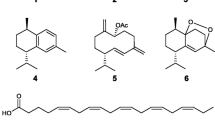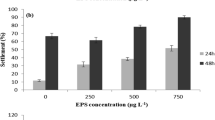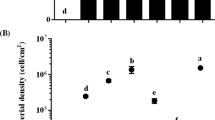Abstract
The bacterial component of marine biofilms plays an important role in the induction of larval settlement in the polychaete Hydroides elegans. In this study, we provide experimental evidence that bacterial metabolites comprise the chemical signal for larval settlement. Bacteria were isolated from biofilms, purified and cultured according to standard procedures. Bacterial metabolites were isolated from spent culture broth by chloroform extraction as well as by closed-loop stripping and adsorption of volatile components on surface-modified silica gel. A pronounced biological activity was exclusively observed when concentrated metabolites were adsorbed on activated charcoal. Larvae did not respond to waterborne metabolites when prevented from contacting the bacterial film surface. These results indicate that an association of the chemical signal with a sorbent-like substratum may be an essential cofactor for the expression of biological activity. The functional role of bacterial exopolymers as an adsorptive matrix for larval settlement signals is discussed.
Similar content being viewed by others
REFERENCES
Bartels-Hardege, H. D., Hardege, J. D., Zeeck, E., MÜller, C., Wu, B.L., and Zhu, M. Y. 1996. Sex pheromones in marine polychaetes: a biologically active volatile compound from the coelomic fluid of female Nereis (Neanthes) japonica (Annelida Polychaeta). J. Exp. Mar. Biol. Ecol. 201: 275–284.
Bonar, D. B., Weiner, R. M., and Colwell, R. R. 1986. Microbial–invertebrate interactions and potential for biotechnology. Microb. Ecol. 12: 101–110.
Brancato, M. S. and Woollacott, R. M. 1982. Effect of microbial films on settlement of bryozoan larvae (Bugula simplex, B. stolonifera, and B. turrita). Mar. Biol. 71: 51–56.
Cameron, R. A. and Hinegardner, R. T. 1974. Initiation of metamorphosis in laboratory cultured sea urchins. Biol. Bull. 146: 335–342.
Carpizo-Ituarte, E. and Hadfield, M. G. 1998. Stimulation of metamorphosis in the polychaete Hydroides elegans Haswell (Serpulidae). Biol. Bull. 194: 14–24.
Chia, F. S. 1978. Perspectives: Settlement and metamorphosis of marine invertebrate larvae, pp. 283–285, in F. S. Chia and M. E. Rice (eds.). Settlement and metamorphosis of Marine Invertebrate Larvae. Elsevier, New York.
Conover, W. J. and Iman, L. 1981. Rank transformations as a bridge between parametric and nonparametric statistics. Am. Stat. 35: 124–129.
Costerton, J. W, Lewandowski, Z., Caldwell, D. E., Korber, D. R., and Lappin-scott, H. M. 1995. Microbial biofilms. Annu. Rev. Microbiol. 49: 711–745.
Cowen, J. P. 1992. Morphological study of marine bacterial capsules: implications for marine aggregates. Mar. Biol. 114: 85–95.
Crisp, D. J. 1974. Factors influencing the settlement of marine invertebrate larvae, pp. 177–265, in P. T. Grant and A. M. Mackie (eds.). Chemoreception in Marine Organisms. Academic Press, London.
Decho, A. W. 1990. Microbial exopolymer secretions in ocean environments: their role(s) in food webs and marine processes. Oceanogr. Mar. Biol. Annu. Rev. 28: 73–153.
Decho, A. W. and Zimmer-Faust, R. K. 1996. Sorption of amino acids and peptides to biofilm exopolymers: relation to larval settlement studies, p. 33. Twenty-Fourth Annual Benthic Ecology Meeting, Columbia, South Carolina. 2042 HARDER, LAU, DAHMS, AND QIAN
Fitt, W. K., Coon, S. L., Walch, M., Weiner, R. M., Colwell, R. M., and Bonar, D. B. 1990. Settlement behavior and metamorphosis of oyster larvae (Crassostrea gigas) in response to bacterial supernatants. Mar. Biol. 106: 389–394.
Gassmann, G., MÜller, D. G., and Fritz, P. 1995. Pheromones in marine algae: a technical approach. Helgol. Meeresunters. 49: 797–804.
Grob, K. and ZÜrcher, F. 1976. Striping of trace organic substances from water. Equipment and procedure. J. Chromatogr 117: 285–294.
HADFIELD, M. G., UNABIA, C. C., SMITH, C. M., and MICHAEL, T. M. 1994. Settlement preferences of the ubiquitious fouler Hydroides elegans, pp. 65–74, in M.-F. Thompson, R. Nagabhushanam, R. Sarojni, and M. Fingerman (eds.). Recent Developments in Biofouling Control. A.A. Balkema, Rotterdam, The Netherlands.
Keough, M. J. and Raimondi, P. T. 1996. Responses of settling invertebrate larvae to bioorganic films: effects of large-scale variation in films. J. Exp. Mar. Biol. Ecol. 207: 59–78.
Kirchman, D., Graham, S., Reish, D., and Mitchell, R. 1982. Bacteria induce settlement and metamorphosis of Janua (Dexiospira) brasiliensis Grube (Polychaeta: Spirorbidae). J. Exp. Mar.Biol. Ecol. 56: 153–163.
Lau, S. C. K. and Qian, P.Y. 1997. Phlorotannins and related compounds as larval settlement inhibitors of a tube-building polychaete Hydroides elegans (Haswell). Mar. Ecol. Prog. Ser. 159: 219–227.
Lau, S. C. K. and Qian, P. Y. 2001. Larval settlement and metamorphosis in the serpulid polychaete Hydroides elegans (Haswell) in response to cues from bacterial films. Mar. Biol. 138:321–328.
Lau, S. C. K., Mak, K. K. W., Chen, F., and Qian, P. Y. 2002. Bioactivity of bacterial strains isolated from marine biofilms in Hong Kong waters for the induction of larval settlement in the marine polychaete Hydroides elegans (Haswell). Mar. Ecol. Prog. Ser. 226: 301–310.
Leitz, T. and Wagner, T. 1993. The marine bacterium Alteromonas espejiana induces metamorphosis of the hydroid Hydractinia echinata. Mar. Biol. 115: 173–178.
Le Tourneux, F. and Bourget, E. 1988. Importance of physical and biological settlement cues used at different spatial scales by the larvae of Semibalanus balanoides. Mar. Biol. 97: 57–66.
Maki, J. S. 1999. The influence of marine microbes on biofouling, pp. 147–171, in M. Fingerman, R. Nagabushanam, and M. Thompson M (eds.). Recent Advances in Marine Biotechnology, Volume 3. Science Publishers, Enfield, New Hampshire.
Maki, J. S. and Mitchell, R. 1985. Involvement of lectins in the settlement and metamorphosis of marine invertebrate larvae. Bull. Mar. Sci. 37: 675–683.
Maki, J. S., Rittschof, D., Samuelson, M. O., Szewzyk, U., Yule, A. B., Kjelleberg, S., Costlow, J. D., and Mitchell, R. 1990. Effect of marine bacteria and their exopolymers on the attachment of barnacle cypris larvae. Bull. Mar. Sci. 46: 499–511.
Mccarty, S., Chasteen, T., Marshall, M., Fall, R., and Bachofen, R. 1993. Phototrophic bacteria produce volatile, methylated sulfur and selenium compounds. FEMS Microbiol. Lett. 112: 93–98.
Neumann, R. 1979. Bacterial induction of settlement and metamorphosis in the planula larvae of Cassiopea andromeda (Cnidaria: Scyphozoa, Rihzostomeae). Mar. Ecol. Prog. Ser. 1: 21–28.
Olivier, F., Tremblay, R., Bourget, E., and Rittschof, D. 2000. Barnacle settlement: field experiments on the influence of larval supply, tidal level, biofilm quality and age on Balanus amphitrite cyprids. Mar. Ecol. Prog. Ser. 199: 185–204.
Pawlik, J. R. 1992. Chemical ecology of the settlement of benthic marine invertebrates. Oceanogr. Mar. Biol. Annu. Rev. 30: 273–335.
Pearce, J. R. and Scheibling, R. E. 1991. Effect of macroalgae, microbial films, and conspecifics on the induction of metamorphosis of the green sea urchin, Strongylocentrotus droebachiensis (M¨uller). J. Exp. Mar. Biol. Ecol. 147: 147–162.
Priesnitz, F. M. 2000. Isolierung und Identifizierung von Pheromonen und mit Pheromonen interferierenden Substanzen bei Platynereis dumerilii (Annelida, Polychaeta). PhD dissertation. University of Oldenburg, Oldenburg, Germany. BACTERIAL METABOLITES AND LARVAL SETTLEMENT 2043
Rees, D. A. 1976. Stereochemistry and binding behavior of carbohydrate chains, pp. 1–42, in W. J. Whelan (ed.). Biochemistry of Carbohydrates. University Park Press, Baltimore, Maryland.
Rittschof, D. 1997. Fouling and natural products as antifoulants, pp. 245–257, in M. Fingerman, R. Nagabhushanam, and M. F. Thompson (eds.). Recent Advances in Marine Biotechnology, Volume 3. Science Publishers, Enfield, New Hampshire.
Rodriguez, R. A. and Epifanio, C. E. 2000. Multiple cues for induction of metamorphosis in larvae of the common mud crab Panopeus herbstii. Mar. Ecol. Prog. Ser. 195: 221–229.
Rodriguez, S. R., Ojeda, F. P., and Inestrosa, C. 1993. Settlement of benthic marine invertebrates. Mar. Ecol. Prog. Ser. 97: 193–207.
Scheltema, R. S. 1974. Biological interactions determining larval settlement of marine invertebrates.Thalassia Jugosl. 10: 263–269.
Schmahl, G. 1985. Induction of stolon settlement in the scyphopolyps of Aurelia aurita (Cnidaria,Schyphozoa, Semaestomeae) by glycolipids of marine bacteria. Helgol. Meeresunters. 39: 117–127.
Strathmann, R. R. and Branscomb, E. S. 1979. Adequacy of cues to favorable sites used by settling larvae of two intertidal barnacles, pp. 77–89, in S. E. Stanczyk (ed.). Reproductive Ecology of Marine Invertebrates, Library in Marine Sciences 9. University of South Carolina.
Strathmann, R. R., Branscomb, E. S., and Vedder, K. 1981. Fatal errors in set as a cost of dispersal and the influence of intertidal flora on set of barnacles. Oecologia 48: 13–18.
Sutherland, I. W. 1985. Biosynthesis and composition of Gram-negative bacterial extracellular and wall polysaccharides. Annu Rev. Microbiol. 39: 243–262.
Szewzyk, U., HolmstrÜm, C., Wrangstadh, M., Samuelsson, M. O., Maki, J. S., and Kjelleberg, S. 1991. Relevance of the exopolysaccharide of marine Pseudomonas sp. strain S9 for the attachment of Ciona intestinalis larvae. Mar. Ecol. Prog. Ser. 75: 259–265.
Unabia, C. R. C. and Hadfield, M. G. 1999. Role of bacteria in larval settlement and metamorphosis of the polychaete Hydroides elegans. Mar. Biol. 133: 55–64.
Weiner, R. M., Walch, M., Labare, M. P., Bonar, D. B., and Colwell, R.R. 1989. Effect of biofilms of the marine bacterium Alteromonas colwelliana (LST) on the set of the oysters Crassostrea gigas (Thunberg, 1793) and C. virginica (Gmelin, 1791). J. Shellfish Res. 8: 117–123.
Wieczorek, S. K. and Todd, C. D. 1998. Biofilm cues and larval settlement. Biofouling 12: 81–118.
Wieczorek, S. K., Clare, A. S., and Todd, C. D. 1995. Inhibitory and facilitatory effects of microbial films on settlement of Balanus amphitrite amphitrite larvae. Mar. Ecol. Prog. Ser. 119: 221–228.
Wisely, B. 1958. The development and settling of a serpulid worm, Hydroides norvegica Gunnerus (Polychaeta). Aust. J. Mar. Freshwater. Res. 9: 351–361.
Zar J. H. (1996) Biostatistical Analysis, 3rd ed. Prentice Hall International, Upper Saddle River, New Jersey.
Zeeck, E., Hardege, J. D., Bartels-Hardege, H., Willig, A., and Wesselmann, G. 1991. Volatile compounds from the coelomic fluid of Nereis succinea. Biological activity as a sex pheromomone. Invertebr. Reprod. Dev. 19: 83–85.
Author information
Authors and Affiliations
Corresponding author
Rights and permissions
About this article
Cite this article
Harder, T., Lau, S.C.K., Dahms, HU. et al. Isolation of Bacterial Metabolites as Natural Inducers for Larval Settlement in the Marine Polychaete Hydroides elegans (Haswell). J Chem Ecol 28, 2029–2043 (2002). https://doi.org/10.1023/A:1020702028715
Issue Date:
DOI: https://doi.org/10.1023/A:1020702028715




